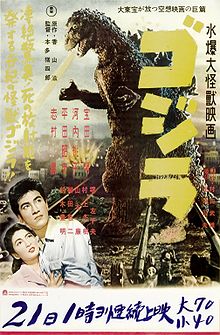
Back كايجو Arabic Kaiju AST Kaiju Catalan کایجو CKB Kaidžú Czech Kaijū German Kaijū Spanish Kaiju Basque کایجو Persian Kaijū Finnish
This article needs additional citations for verification. (September 2024) |

Kaiju (Japanese: 怪獣, Hepburn: kaijū, lit. 'strange beast'; Japanese pronunciation: [ka̠iʑɨː]) is a Japanese term that is commonly associated with media involving giant monsters. Its widespread contemporary use is credited to tokusatsu (special effects) director Eiji Tsuburaya and filmmaker Ishirō Honda, who popularized the kaiju film genre by creating the Godzilla franchise and its spin-offs.[1] The term can also refer to the monsters themselves, which are usually depicted attacking major cities and battling either the military or other creatures.
Godzilla (1954) is often regarded as the first kaiju movie. When developing it, Honda and Tsuburaya drew inspiration from the character of King Kong, both in its influential 1933 film and in the conception of a giant monster, establishing it as a pivotal precursor in the evolution of the genre.[2] During its formative years, kaiju movies were generally neglected by Japanese critics, who regarded them as "juvenile gimmick", according to authors Steve Ryfle and Ed Godziszewski.[1]
Kaiju are often somewhat metaphorical in nature; Godzilla, for example, initially served as a metaphor for nuclear weapons, reflecting the fears of post-war Japan following the atomic bombings of Hiroshima and Nagasaki and the Lucky Dragon 5 incident. Other notable examples of kaiju include Rodan, Mothra, King Ghidorah, and Gamera.
- ^ a b Ryfle, Steve; Godziszewski, Ed (2017). Ishiro Honda: A Life in Film, from Godzilla to Kurosawa. Wesleyan University Press. pp. xiii–xiv. ISBN 9780819570871.
- ^ King Kong’s influence on the giant monster genre:
- Newby, Richard (December 9, 2023). "20 Godzilla Monsters, Ranked From Best to Worst". The Hollywood Reporter.
- Del Palacio, Guillermo (April 6, 2015). "Top 25 best monster movies". IGN.
- Amiguet, Teresa (July 3, 2013). "King Kong, a bestial love". La Vanguardia.
- Vallin Madrid, Pedro (February 6, 2023). "Tiny men face colossi". La Vanguardia.
- Jiménez, Jesús (August 11, 2016). "The true story of Godzilla and his friends". RTVE.
- "Disney+ plans to produce a new "King Kong" series". El Espectador. August 24, 2022.
- Sosa, Kike (July 19, 2013). "King of Monsters". ABC Color.
- "Five kaiju movies you can watch on Netflix". Red Bull. May 30, 2019.
- Meyer, Joshua (March 29, 2021). "How The Original 'King Kong' Influenced 'Godzilla' (And How Lesser-Known Dino Movies Influenced Them Both)".
- Rahman, Abid (December 3, 2023). "'Godzilla x Kong: The New Empire' Trailer Sees Epic Kaiju Team Up". The Hollywood Reporter.
- Newby, Richard (April 2, 2021). "'Godzilla vs. Kong' and the Future of the MonsterVerse". The Hollywood Reporter.
- "Next Monsterverse film titled 'Godzilla x Kong: The New Empire'". The Hindu. April 20, 2023. Archived from the original on 2023-04-20.
- Di Placido, Dani (January 24, 2021). "There Will Be No Winner In 'Godzilla Vs. Kong'". Forbes.
- Draven, Derek (June 13, 2021). "Godzilla: The 15 Most Iconic Kaiju, Ranked". Screen Rant.